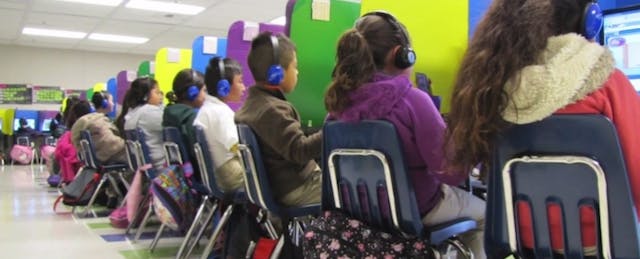Among the education reform movement, Rocketship Education’s blended learning model has been hailed as an exemplar of continuous innovation. Every year it tries new technologies, tools and practices.
But not all “innovations” work out the way they are envisioned. This spring, school leaders faced a hard decision--whether to continue on course with a radical and bold experiment for its fourth and fifth grade classes across its nine schools, or scrap the changes and return back to business as usual.
Over the past six years, the San Jose, CA-based charter school network has developed a replicable blended learning model. Students spend 75% of their time in traditional classes, where one teacher instructs 27 students. They then rotate into a learning lab, where they spend the rest of their time on adaptive educational software to sharpen their skills.
At the beginning of the 2013-14 school year, Rocketship decided to shake things up for its fourth and fifth grade students. Instead of rotating between the learning lab and classroom, they were put in “flexible” classrooms, an open space that held 100 students for the entire school day. Three teachers and one learning coach decided everything from the class schedule to how the 60 Chromebooks were used.
The model was supposed to give teachers greater freedom to assess and meet the ongoing needs for each student. “The appeal was to extend the reach of great teachers by allowing them greater flexibility and autonomy in grouping students and tailoring lessons in order to further personalize learning,” says Rocketship’s manager of growth and policy Charlie Bufalino.
In a class of 100, one teacher could give a lecture to 20 students, much like a traditional classroom. Meanwhile, another teacher could oversee small group projects for 30 students. 40 students could be working independently online, with the remaining 10 receiving one-on-one tutoring from the third teacher.
Rocketship representatives say they saw gains from the new model, especially in non-cognitive skills such as students’ self-control and the ability to self-monitor one’s work. Academic outcomes have yet to be analyzed, as the school is waiting for California Standards Tests (CST) results to be reviewed by an independent auditor.
Discontinuing The New Model
While these “flexible classrooms” gave teachers the ability to further “personalize” learning for students, the lack of a formal structure made it difficult for Rocketship to replicate and control quality.
Teachers were expected to be dynamic and collaborative, with roles that were regularly shifting. They had a great deal of autonomy in defining what classroom time looked like and deciding when different modes of instruction--lecture, small group project, or individual online exercises--would be best for each student.
But unstructured freedom has a price, and many teachers initially were unenthusiastic with the dramatic change in the model. Rocketship admits that at the beginning of the 2013-2014 school year, only 4% of teachers approved of the new model. However, by the end of the year 67% were on board.
“These changes are new and scary. Teachers were not sure what it looked like, but as they moved throughout the year, their confidence around the model shifted,” explained Caryn Voskuil, Rocketship’s former Manager of School Model Innovation.
But even as teacher attitudes changed, it wasn’t enough. Making a “flexible classroom” work requires a high degree of teacher expertise, along with extensive training and coaching. Currently, the profession is not set up to develop such experts early on in a teacher’s career. Most new teacher rely on pre-determined schedules and procedures, with clearly defined expectations about their work, in order to focus on building basic teaching skills. Without these structures, it becomes difficult for a novice teacher to exercise command of a classroom.
“We did see really good gains from the ‘flexible classrooms.’ But we found they depended a lot on the dynamic of the team… and that dynamic is difficult to control and predict,” says Bufalino, “So thinking about scaling and building it into a model was difficult.”
Lessons Learned
With ambitious plans to add 40 schools in five new cities, including 20 more in San Jose by 2020, the charter management organization decided to revert to the rotational model--but not without assessing the gains and making tweaks from the lessons learned.
“We learned a lot about what our teachers wanted,” says Bufalino, “They wanted more access to computers in their classroom,” and Rocketship will stock each third- to fifth-grade class with a set of 10 Chromebooks in both math/science and humanities classes. In addition, teachers also appreciated the opportunity to collaborate in the flexible classrooms and will be given more time for common planning going forward.
Rocketship also learned a lot about the potential of flexible groupings. “It gave us opportunity to divert numbers of kids from different times of the day. And we want to preserve opportunities to do dynamic groupings next school year,” says Voskuil. For the upcoming school year, the schools will implement a “flex block,” a 40-minute period where students in the same grade level (but across different homerooms) will be grouped based on their skills and work collaboratively on targeted practice assignments.
Rocketship hopes that these legacies of the “flexible classrooms” will add a greater deal of personalization to its old model. However, this addition to the rotation model is seen an optional enhancement for schools to choose when they are ready. “It’s a sophisticated move. Depending on where they are at, we don’t recommend it for a school in year one or year two,” says Voskuil.


